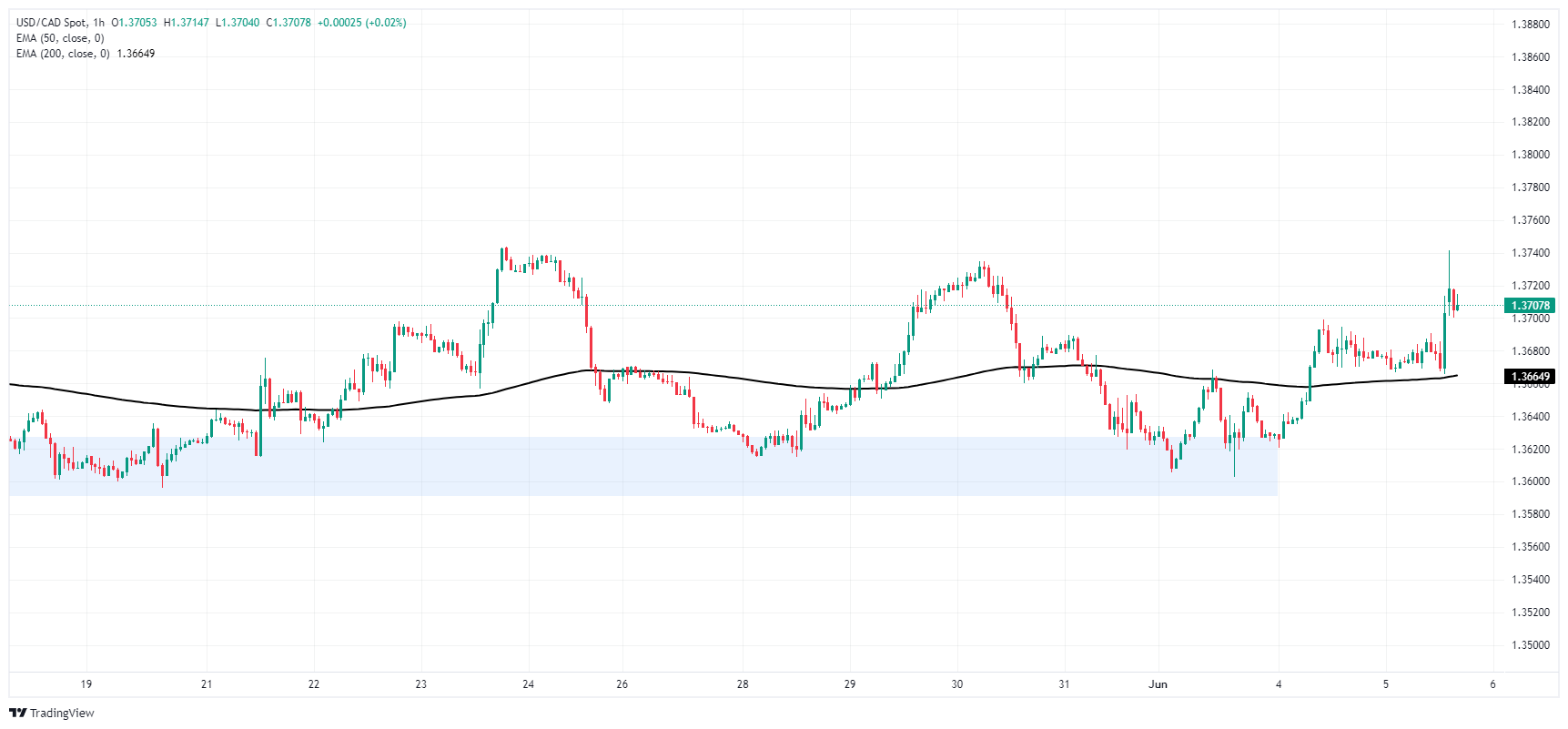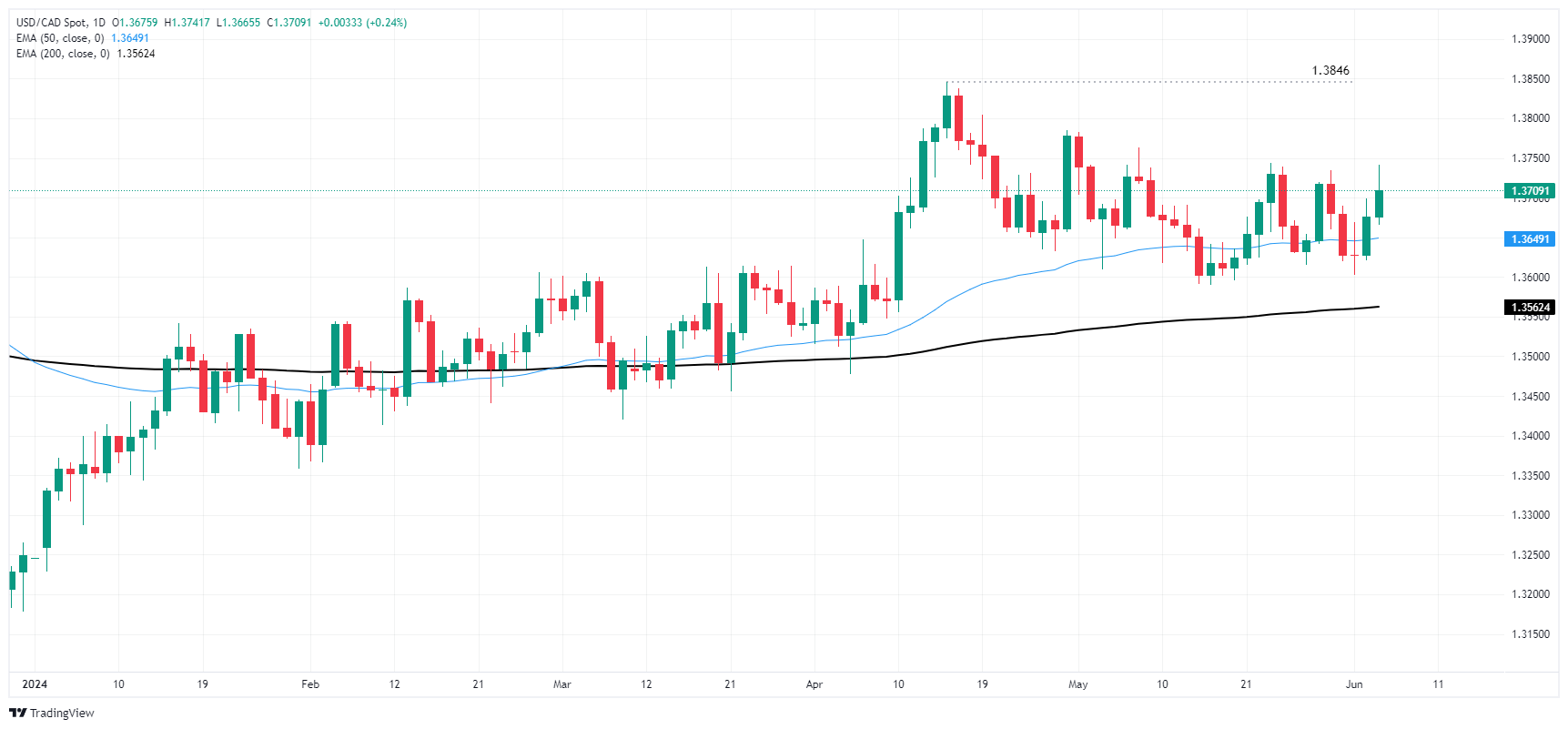- Analytics
- News and Tools
- Market News
- Canadian Dollar churns on Wednesday after BoC rate cut
Canadian Dollar churns on Wednesday after BoC rate cut
- Canadian Dollar loses minor ground against Greenback after BoC rate cut.
- Canada delivers broadly expected rate trim, but BoC sticks to per meeting outlook.
- Markets set to pivot to Friday’s US NFP and Canadian labor figures.
The Canadian Dollar (CAD) backslid against the US Dollar (USD) during Wednesday’s US market session, briefly sending USD/CAD to a near-term high of 1.3740 before markets faded the move back to the 1.3700 handle. The Bank of Canada (BoC) delivered a broadly expected quarter-point rate cut, but US ISM Services Purchasing Managers Index (PMI) figures in June unexpectedly rose to a nine-month high.
Canada has notched a first rate cut from the BoC on Wednesday, and CAD traders will pivot to focus on Friday’s upcoming Canadian labor figures. However, another US Nonfarm Payrolls (NFP) jobs print will likely overshadow Canadian employment data in that session.
Daily digest market movers: BoC moves on rates, meets market expectations
- BoC cut its main reference rate by 25 basis points to 4.75% from 5.0%.
- During the BoC’s Monetary Policy Statement, BoC Governor Tiff Macklem noted that the BoC’s policy decisions on future rate cuts will be considered one meeting at a time.
- US ISM Services PMI rebounds to nine-month high of 53.8 in May, above forecast of 50.8 and recovering from April’s 16-month low of 49.4.
- US ADP Employment Change in May came in lower than expected, printing at 152K in May and missing the 173K forecast. The previous month was also revised slightly lower to 188K from 192K.
- Interest rate market bets of a November Federal Reserve rate cut have risen to 80%.
- BoC's Macklem: Confidence on inflation returning to 2.0% remains in place
- Macklem speech: It is looking like a soft landing for the economy
Canadian Dollar PRICE Today
The table below shows the percentage change of Canadian Dollar (CAD) against listed major currencies today. Canadian Dollar was the strongest against the Japanese Yen.
| USD | EUR | GBP | JPY | CAD | AUD | NZD | CHF | |
|---|---|---|---|---|---|---|---|---|
| USD | 0.12% | -0.07% | 0.80% | 0.19% | 0.09% | -0.14% | 0.43% | |
| EUR | -0.12% | -0.19% | 0.68% | 0.07% | -0.02% | -0.24% | 0.27% | |
| GBP | 0.07% | 0.19% | 0.86% | 0.27% | 0.17% | -0.05% | 0.48% | |
| JPY | -0.80% | -0.68% | -0.86% | -0.61% | -0.71% | -0.95% | -0.41% | |
| CAD | -0.19% | -0.07% | -0.27% | 0.61% | -0.09% | -0.31% | 0.21% | |
| AUD | -0.09% | 0.02% | -0.17% | 0.71% | 0.09% | -0.23% | 0.31% | |
| NZD | 0.14% | 0.24% | 0.05% | 0.95% | 0.31% | 0.23% | 0.54% | |
| CHF | -0.43% | -0.27% | -0.48% | 0.41% | -0.21% | -0.31% | -0.54% |
The heat map shows percentage changes of major currencies against each other. The base currency is picked from the left column, while the quote currency is picked from the top row. For example, if you pick the Canadian Dollar from the left column and move along the horizontal line to the US Dollar, the percentage change displayed in the box will represent CAD (base)/USD (quote).
Economic Indicator
BoC Interest Rate Decision
The Bank of Canada (BoC) announces its interest rate decision at the end of its eight scheduled meetings per year. If the BoC believes inflation will be above target (hawkish), it will raise interest rates in order to bring it down. This is bullish for the CAD since higher interest rates attract greater inflows of foreign capital. Likewise, if the BoC sees inflation falling below target (dovish) it will lower interest rates in order to give the Canadian economy a boost in the hope inflation will rise back up. This is bearish for CAD since it detracts from foreign capital flowing into the country.
Read more.Last release: Wed Jun 05, 2024 13:45
Frequency: Irregular
Actual: 4.75%
Consensus: 4.75%
Previous: 5%
Source: Bank of Canada
Technical analysis: Canadian Dollar edges lower on Wednesday as Greenback gains
The Canadian Dollar is mixed on Wednesday, rising nearly half a percent against the Japanese Yen but falling around a quarter of a percent against the US Dollar. The CAD’s backslide sparked a brief rise in the pair to 1.3740 before cooler heads prevailed and pushed the pair back toward the 1.37000.
Daily candlesticks reveal the pair mired in near-term congestion with bids waffling close to the 50-day Exponential Moving Average (EMA) at 1.3649. 2024’s high currently sits at 1.3846, while overall USD/CAD remains up around 3.5% for the year.
USD/CAD hourly chart
USD/CAD daily chart
Canadian Dollar FAQs
The key factors driving the Canadian Dollar (CAD) are the level of interest rates set by the Bank of Canada (BoC), the price of Oil, Canada’s largest export, the health of its economy, inflation and the Trade Balance, which is the difference between the value of Canada’s exports versus its imports. Other factors include market sentiment – whether investors are taking on more risky assets (risk-on) or seeking safe-havens (risk-off) – with risk-on being CAD-positive. As its largest trading partner, the health of the US economy is also a key factor influencing the Canadian Dollar.
The Bank of Canada (BoC) has a significant influence on the Canadian Dollar by setting the level of interest rates that banks can lend to one another. This influences the level of interest rates for everyone. The main goal of the BoC is to maintain inflation at 1-3% by adjusting interest rates up or down. Relatively higher interest rates tend to be positive for the CAD. The Bank of Canada can also use quantitative easing and tightening to influence credit conditions, with the former CAD-negative and the latter CAD-positive.
The price of Oil is a key factor impacting the value of the Canadian Dollar. Petroleum is Canada’s biggest export, so Oil price tends to have an immediate impact on the CAD value. Generally, if Oil price rises CAD also goes up, as aggregate demand for the currency increases. The opposite is the case if the price of Oil falls. Higher Oil prices also tend to result in a greater likelihood of a positive Trade Balance, which is also supportive of the CAD.
While inflation had always traditionally been thought of as a negative factor for a currency since it lowers the value of money, the opposite has actually been the case in modern times with the relaxation of cross-border capital controls. Higher inflation tends to lead central banks to put up interest rates which attracts more capital inflows from global investors seeking a lucrative place to keep their money. This increases demand for the local currency, which in Canada’s case is the Canadian Dollar.
Macroeconomic data releases gauge the health of the economy and can have an impact on the Canadian Dollar. Indicators such as GDP, Manufacturing and Services PMIs, employment, and consumer sentiment surveys can all influence the direction of the CAD. A strong economy is good for the Canadian Dollar. Not only does it attract more foreign investment but it may encourage the Bank of Canada to put up interest rates, leading to a stronger currency. If economic data is weak, however, the CAD is likely to fall.
© 2000-2024. All rights reserved.
This site is managed by Teletrade D.J. LLC 2351 LLC 2022 (Euro House, Richmond Hill Road, Kingstown, VC0100, St. Vincent and the Grenadines).
The information on this website is for informational purposes only and does not constitute any investment advice.
The company does not serve or provide services to customers who are residents of the US, Canada, Iran, The Democratic People's Republic of Korea, Yemen and FATF blacklisted countries.
Making transactions on financial markets with marginal financial instruments opens up wide possibilities and allows investors who are willing to take risks to earn high profits, carrying a potentially high risk of losses at the same time. Therefore you should responsibly approach the issue of choosing the appropriate investment strategy, taking the available resources into account, before starting trading.
Use of the information: full or partial use of materials from this website must always be referenced to TeleTrade as the source of information. Use of the materials on the Internet must be accompanied by a hyperlink to teletrade.org. Automatic import of materials and information from this website is prohibited.
Please contact our PR department if you have any questions or need assistance at pr@teletrade.global.















